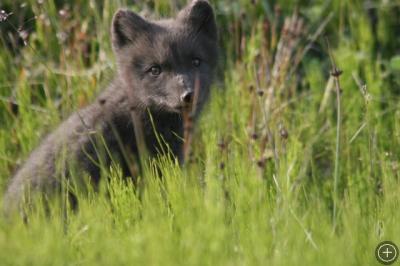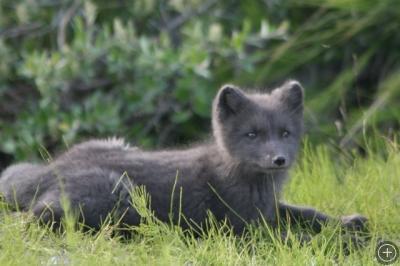Fox in Two Colors
KANGERLUSSUAQ, GREENLAND– On our excursions out of Kanger, Lisa and I always had our eyes peeled for wildlife. We were hoping to catch sight of one of the big mammals: musk oxen or caribou. But on our way back from the ice edge last week, Lisa spotted four little ears bobbing in a ditch by the side of the road. Jason Buening, our guide from polar services, stopped the car and we all recognized at once that these were two Arctic Fox kits.
The foxes seemed as curious of us as we were of them and they posed for our cameras a good fifteen minutes. They used a drainage pipe as refuge, popping in and out until one of them boldly trotted up on the road and sniffed the air in our direction. The other soon followed behind. We heard a strange call, a loud yipping with a high-pitched yowl at the end, sounding every bit the worried mother warning her babies to get out of dodge. The kits paid her no mind, continuing instead to stare at the three of us.
They were the same size and probably from the same litter, but were two different colors. I found out later that Arctic Foxes have two color variants, white and blue, just as Labrador retrievers from the same litter can be yellow or black. The white coat is more common, blues make up about one quarter of the Arctic Fox population. Arctic Foxes molt twice a year, their summer coats are darker and more mottled than the winter coats.
Arctic Foxes are very well adapted to a cold environment and live almost exclusively north of the Arctic circle. They have a luxurious thick coat and even have fur on the soles of their feet. Their snout, ears, and legs are shorter and more blunted than their more temperate cousins, helping them conserve body heat in winter temperatures that can dip below –58 F (-50 C).
Skilled hunters, Arctic Foxes can usually find abundant prey among the lemmings, hares, birds and fish in their treeless habitat, but they are not above scavenging food from polar bears (taking care to avoid becoming a snack for the bear). The Arctic Fox is circumpolar, found throughout Northern Canada, Russia, Greenland, Alaska, and Svalbard and also in Subarctic Scandinavia and Iceland (where it is that island nation’s only land mammal). In most of its range, the fox is not endangered, except the mainland population of Scandinavia. Here in Greenland they are a common sight in both summer and winter throughout the coastal margins.
We were charmed by the company of these bold fox kits, but it was time to return to KISS for dinner so we hopped back in the truck and the youngsters returned to the shelter of their drain pipe.














Very cool Aunty Mary i love foxes!
i loved those foxes they are so cool
Cool site, i will come back here, regards